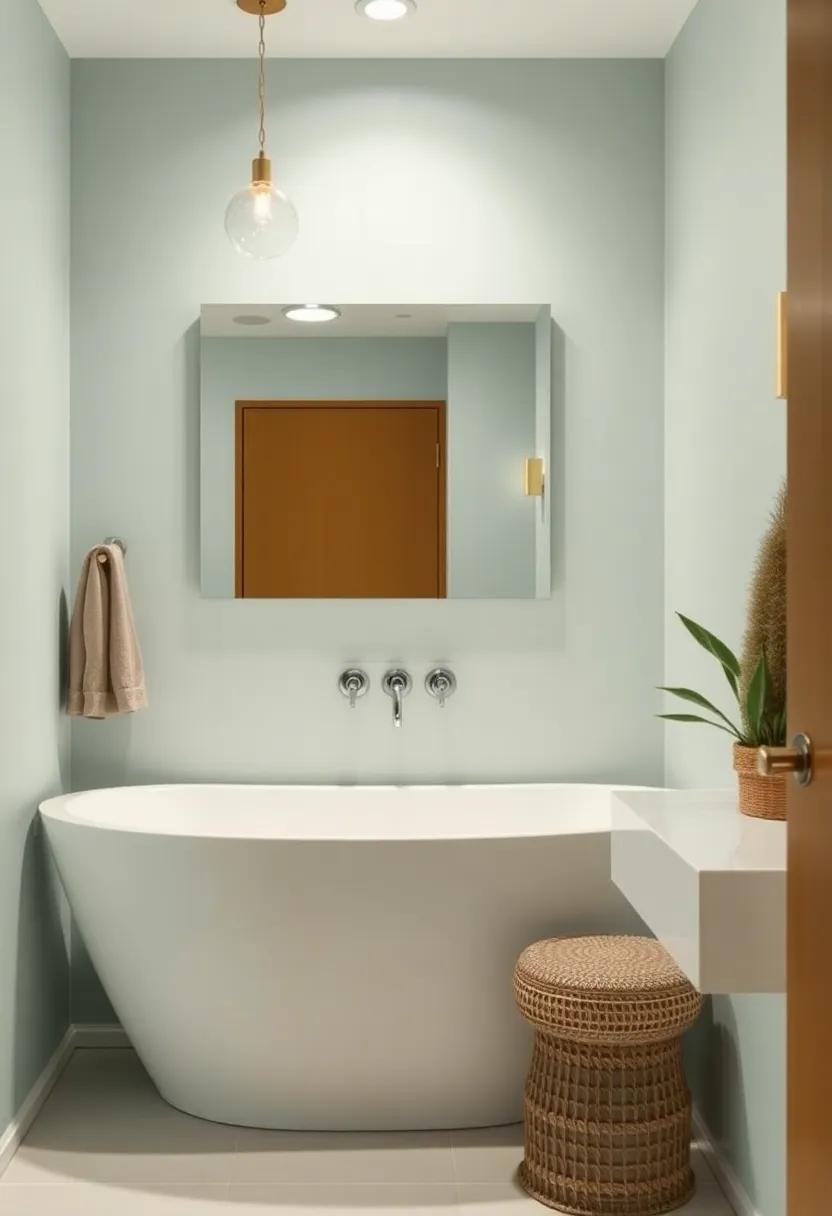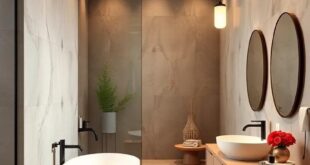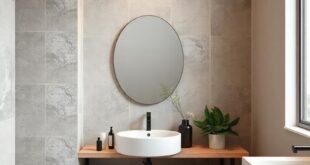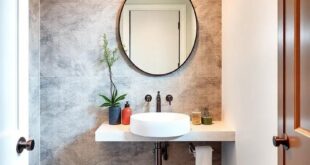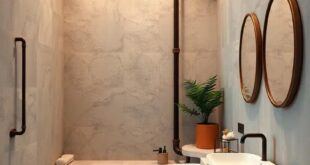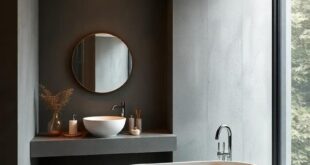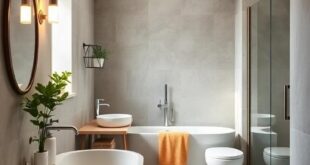Step into a time capsule where sleek lines meet timeless elegance, and the past whispers its secrets to the present. the midcentury bathroom, a hallmark of design innovation from the 1940s to the 1960s, is experiencing a renaissance, captivating homeowners and designers alike with its effortless blend of form and function.Characterized by clean geometries, organic materials, and a touch of playful nostalgia, this iconic style has proven its staying power, transcending trends to remain a beloved aesthetic in modern interiors.As the retro revival sweeps through contemporary homes, the midcentury bathroom emerges as a sanctuary of simplicity and sophistication—a testament to the enduring allure of thoughtful design. Join us as we explore the elements that make this era’s bathrooms not just a relic of the past, but a blueprint for timeless charm.
The Allure of Pastel Tones in Midcentury Bathroom Aesthetics
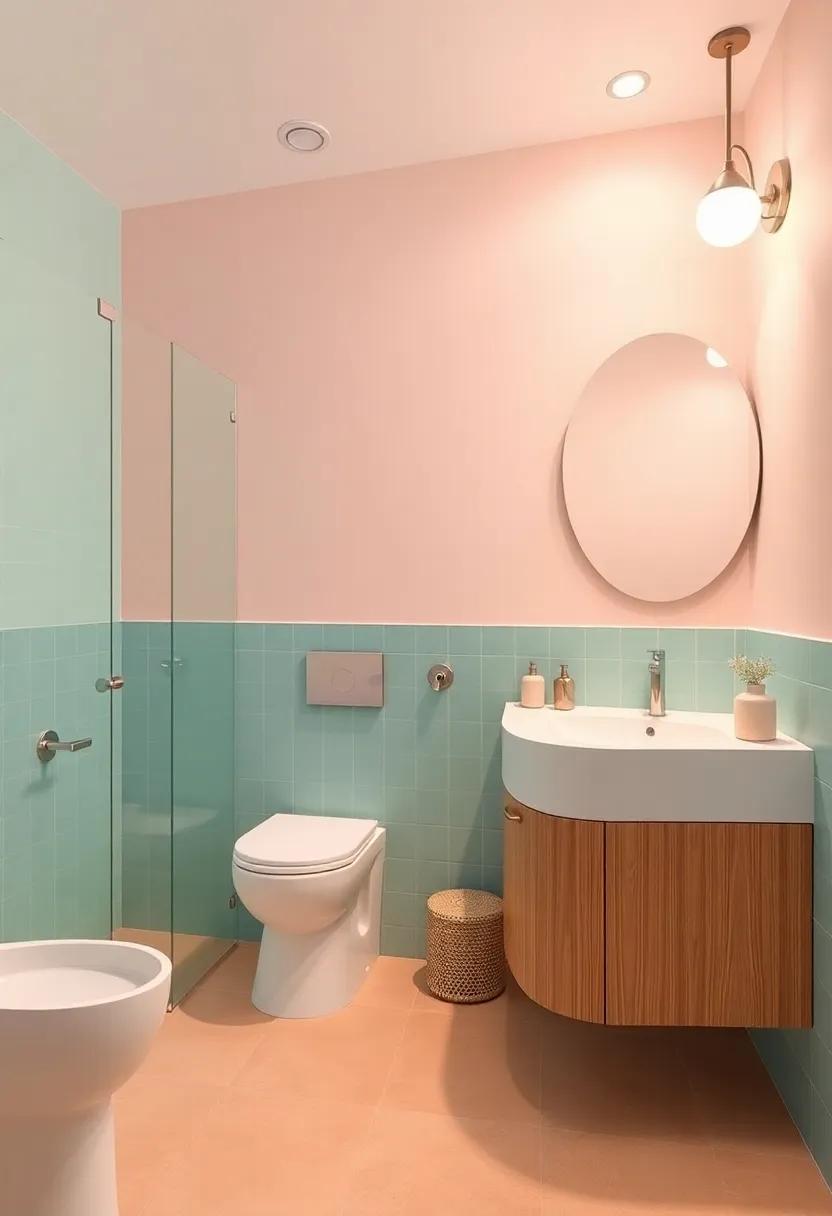
Midcentury bathroom design is synonymous with a sense of nostalgia, and nothing captures this essence better than the soft, inviting hues of pastel tones. From mint greens to blush pinks and powder blues, these colors evoke a serene, almost dreamlike quality that transforms the bathroom into a tranquil retreat. The use of pastels isn’t just about aesthetics; it’s a nod to the optimism and innovation of the mid-20th century, where design was as much about functionality as it was about beauty. Pairing these tones with clean lines and minimalist fixtures creates a harmonious balance, making the space feel both timeless and refreshingly modern.
To truly embrace the allure of pastel tones, consider incorporating them into key elements of your bathroom design. Here are a few ideas to get started:
- Wall tiles: Opt for subway tiles in soft pastel shades for a classic yet contemporary look.
- Fixtures: Choose matte finishes in muted gold or brushed nickel to complement the pastel palette.
- Accessories: Add vintage-inspired soap dispensers, towels, or artwork to enhance the retro vibe.
| Pastel Tone | Matching Accent | Design Tip |
|---|---|---|
| Mint Green | Brass Hardware | Pair with white marble for a crisp, clean contrast. |
| Blush Pink | Terrazzo Flooring | Add black accents for a bold, modern twist. |
| Powder Blue | Wooden Cabinets | use natural textures to create warmth and depth. |
Geometric Patterns That Define the Midcentury Bathroom Style
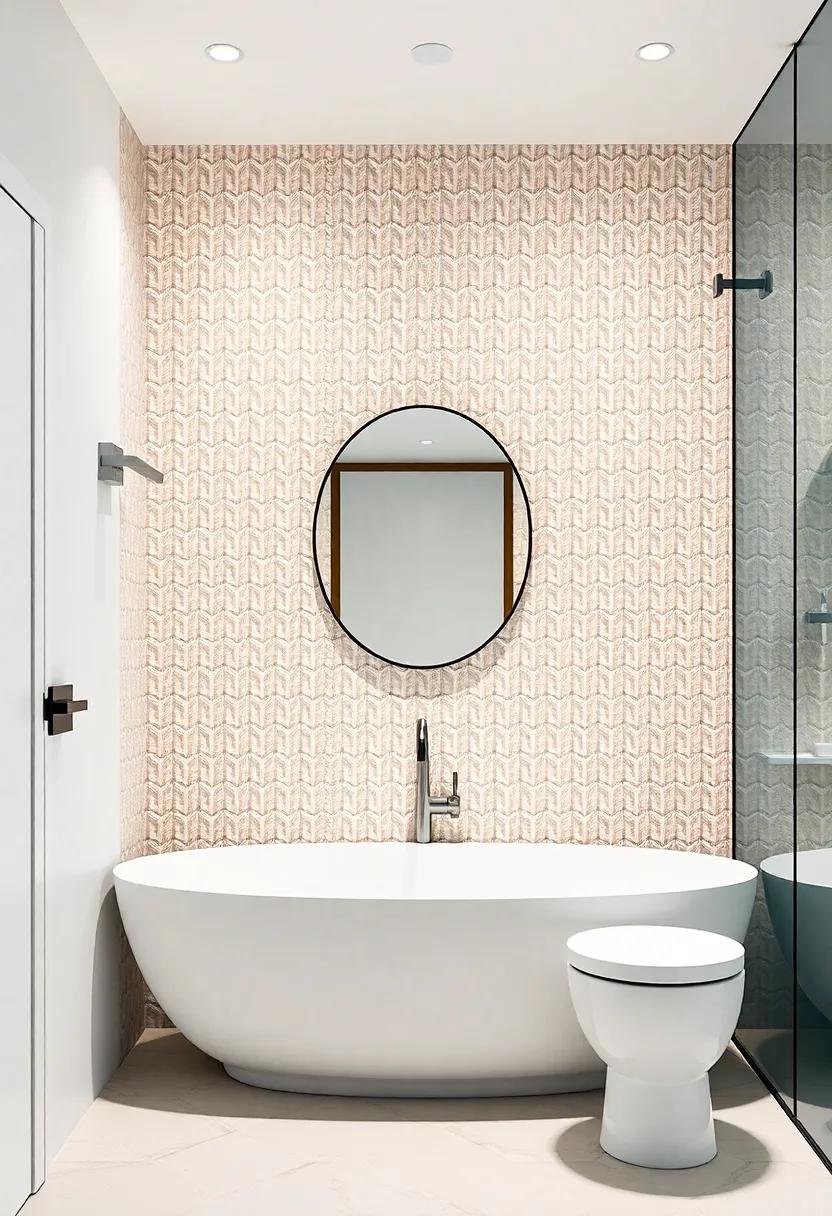
Midcentury bathroom design is synonymous with clean lines, organic shapes, and a harmonious blend of form and function. Geometric patterns play a pivotal role in defining this iconic style, offering a visual rhythm that feels both retro and refreshingly modern. From hexagonal floor tiles to diamond-shaped wall accents, these patterns create a sense of movement and balance. Bold, contrasting colors like teal, mustard yellow, and charcoal gray often accompany these shapes, amplifying their impact. Whether it’s a herringbone backsplash or a sunburst mirror, these geometric elements infuse the space with a timeless energy that transcends decades.
to truly capture the essence of midcentury design,consider incorporating these geometric features into your bathroom:
- Hexagonal Tiles: A classic choice for flooring or shower walls,these tiles add texture and depth.
- Chevron Patterns: Perfect for accent walls or shower curtains, they bring a dynamic, zigzag energy.
- Circular Fixtures: Round mirrors, light fixtures, or even circular shelving soften the angularity of other patterns.
| Pattern | Best Use | Colour Pairing |
|---|---|---|
| Hexagonal Tiles | Flooring, Shower Walls | Teal & White |
| Chevron | Accent Walls, Curtains | Mustard & Charcoal |
| Circular Fixtures | Mirrors, Lighting | Black & Gold |
Vintage Fixtures and their Role in Crafting Timeless Spaces
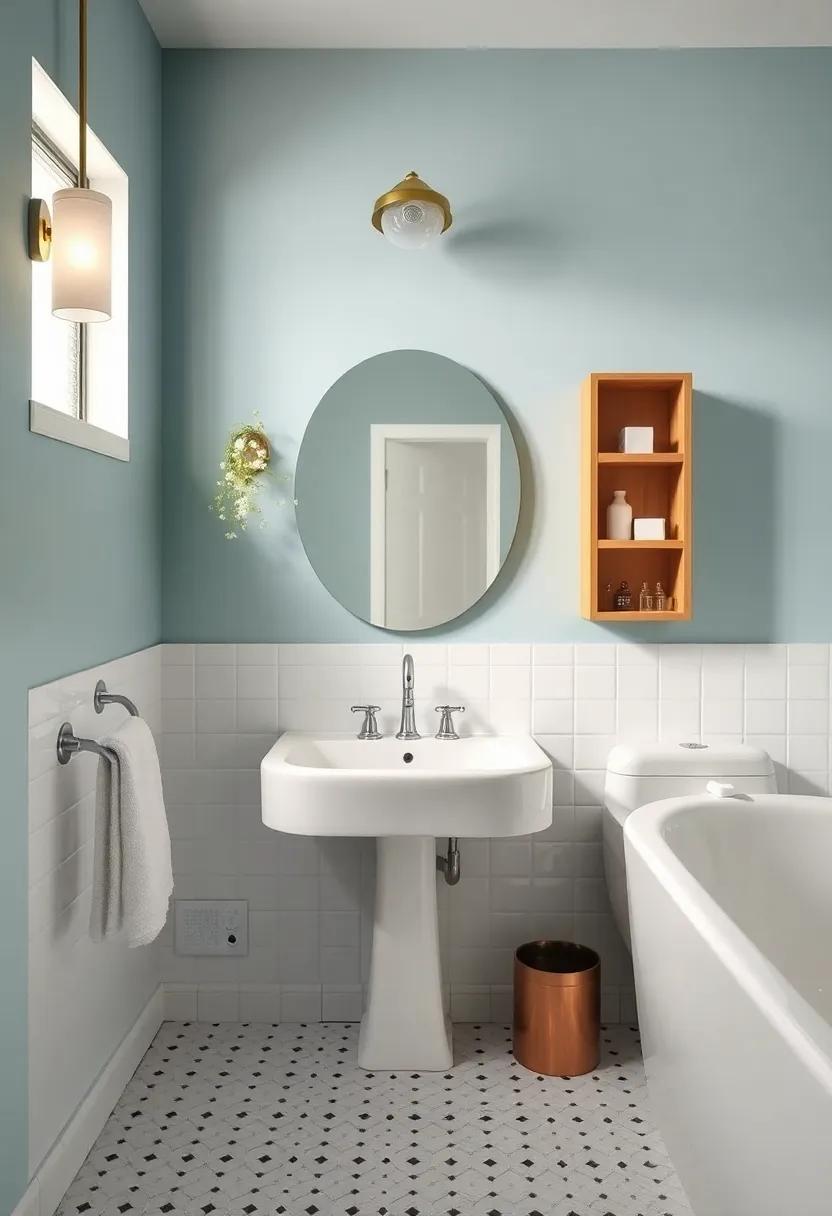
Vintage fixtures are the unsung heroes of midcentury bathroom design, effortlessly blending functionality with aesthetic appeal. From sleek chrome faucets to bold geometric tile patterns, these elements evoke a sense of nostalgia while maintaining their relevance in modern interiors. Key features like wall-mounted vanities,pastel-colored ceramics,and sunburst mirrors not only define the era but also create a cohesive,timeless look. By incorporating these pieces, you can transform an ordinary bathroom into a retro-inspired sanctuary that feels both fresh and familiar.
To achieve the perfect balance, consider mixing vintage fixtures with contemporary touches. Such as, pair a clawfoot tub with minimalist lighting or combine a retro medicine cabinet with modern hardware. Below is a quick guide to help you curate your space:
- Lighting: Opt for globe-shaped sconces or pendant lights with brass finishes.
- Fixtures: Choose cross-handle faucets and showerheads with a polished chrome finish.
- Accessories: Add vintage-inspired soap dispensers, towel racks, and patterned shower curtains.
| Element | Vintage Style | Modern Twist |
|---|---|---|
| Vanity | Wall-mounted, wood finish | Floating design with matte black hardware |
| Mirror | Sunburst or oval frame | Frameless, backlit option |
| Flooring | Hexagonal tiles in pastel hues | Large-format tiles in neutral tones |
The Warmth of Natural Wood Accents in Retro Bathroom Design
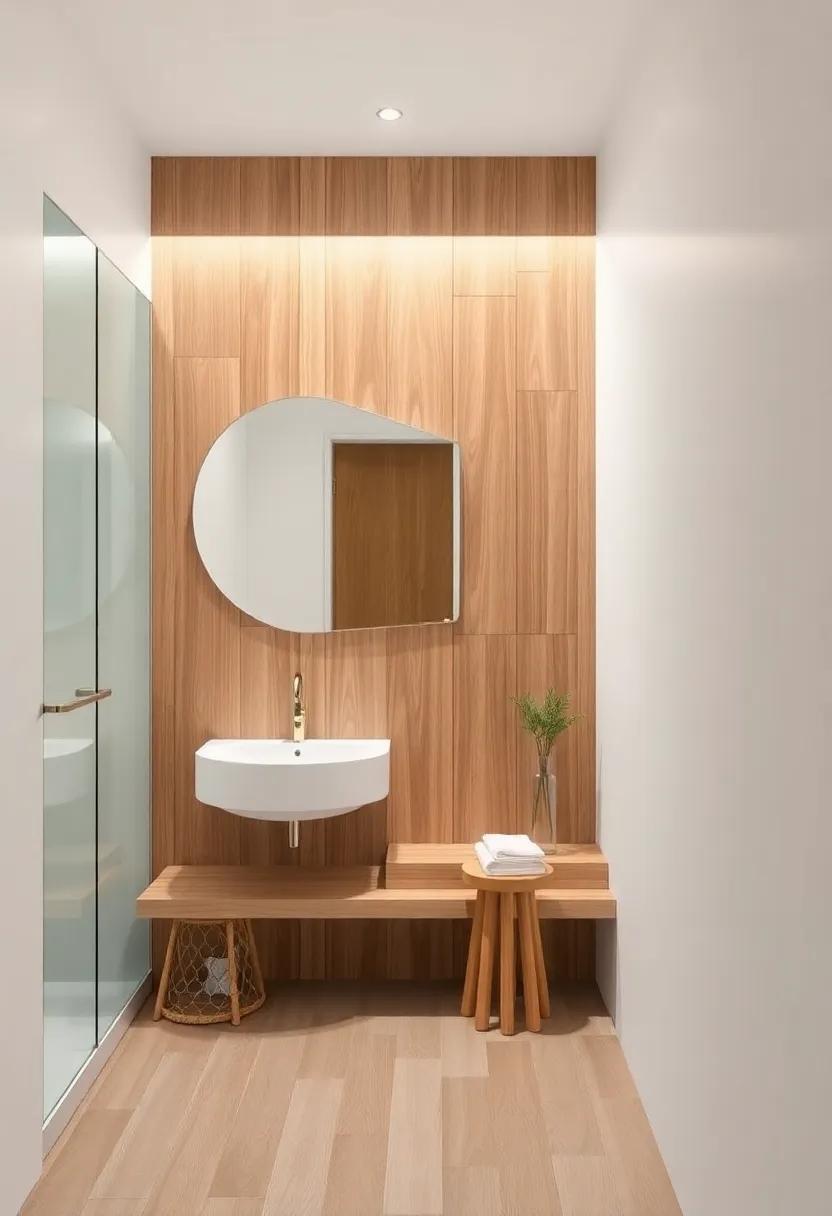
Incorporating natural wood accents into a retro bathroom design brings an undeniable warmth and organic charm to the space.The rich textures and earthy tones of wood create a striking contrast against the sleek lines and bold colors frequently enough associated with midcentury aesthetics. Whether it’s a teak vanity, walnut shelving, or bamboo towel racks, these elements infuse the room with a sense of timeless elegance. Pairing wood with retro fixtures like pastel tiles or chrome hardware enhances the nostalgic vibe while maintaining a modern, cohesive look.
To achieve the perfect balance, consider these key elements:
- Teak Vanities: A classic choice that adds both functionality and style.
- Walnut Accent Walls: Create a focal point with a textured wood panel.
- Bamboo Accessories: Introduce subtle warmth with towel racks or mirrors.
| Wood Type | Best Use |
|---|---|
| Teak | Vanities, Cabinets |
| Walnut | Accent Walls, Shelving |
| bamboo | Accessories, Mirrors |
Terrazzo Floors and Their Resurgence in Modern Retro Bathrooms
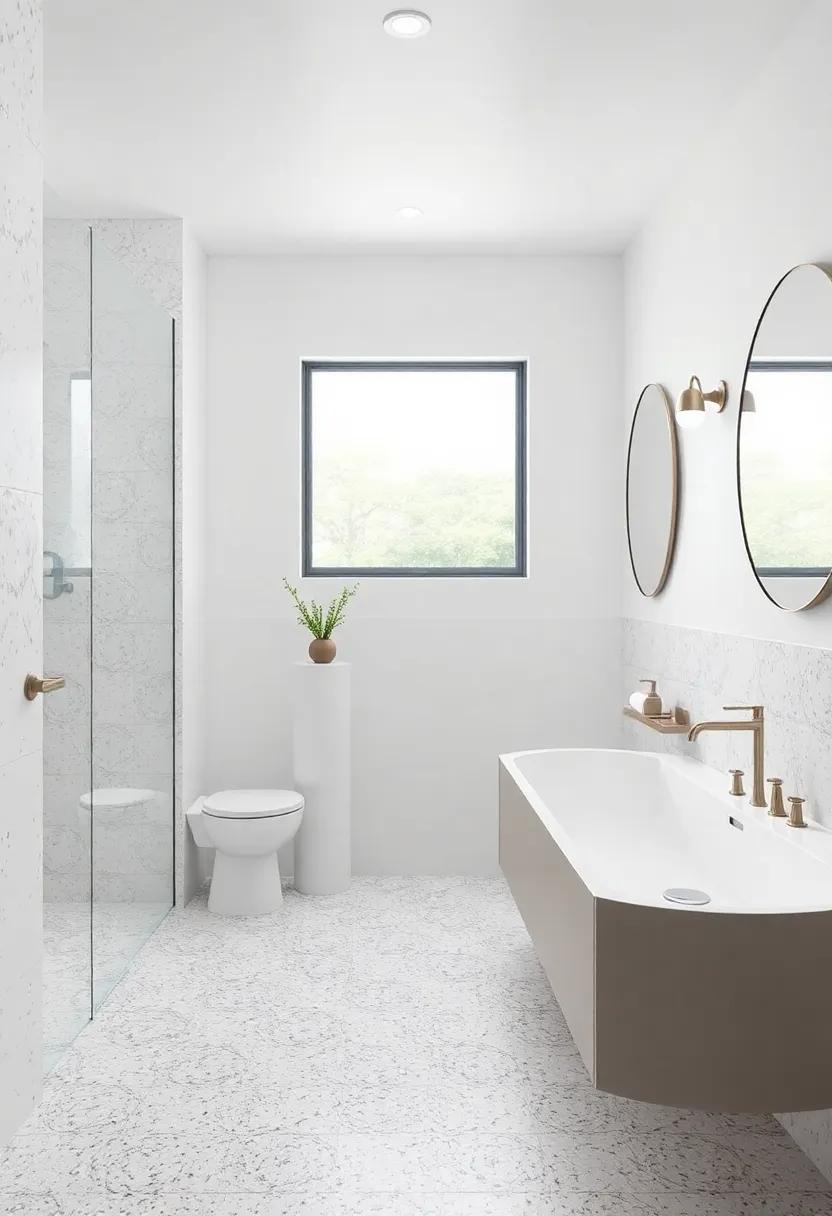
One of the most striking elements of midcentury bathroom design making a bold comeback is the use of terrazzo flooring. This versatile material, once a staple of 1950s and 60s interiors, is now being reimagined in modern retro spaces. Its speckled appearance, created by embedding chips of marble, quartz, or glass in a cement or resin base, adds a playful yet sophisticated touch to bathrooms. Designers are embracing terrazzo not only for its durability but also for its ability to seamlessly blend with a variety of color palettes, from muted pastels to vibrant hues.
Today’s terrazzo floors are far from the utilitarian versions of the past. They are being customized to suit contemporary tastes, with options like:
- Bold color combinations – Think terracotta paired with deep blues or emerald greens.
- Larger aggregate pieces – Creating a more dramatic, artistic effect.
- Polished finishes – Adding a sleek, reflective surface that enhances natural light.
| Terrazzo style | Best Paired With |
|---|---|
| Neutral Tones | Wooden vanities, brass fixtures |
| Vibrant Colors | Geometric tiles, matte black accents |
| Monochrome | Minimalist decor, chrome finishes |
Whether used as a statement floor or as subtle accents in shower niches or countertops, terrazzo brings a sense of nostalgia while feeling entirely fresh. Its resurgence is a testament to the enduring appeal of midcentury design,proving that some trends truly never go out of style.
The Iconic Pedestal Sink and Its Enduring Midcentury Appeal
![]()
Few elements capture the essence of midcentury design quite like the pedestal sink. With its clean lines, minimalist silhouette, and timeless elegance, this fixture has become a hallmark of retro-inspired bathrooms. Its enduring appeal lies in its ability to blend seamlessly with both vintage and modern aesthetics, making it a versatile choice for homeowners seeking a touch of nostalgia. The pedestal sink’s design emphasizes functionality without sacrificing style, offering a clutter-free look that enhances the sense of space—a key principle of midcentury design.
When paired with other midcentury elements, the pedestal sink transforms a bathroom into a retro haven. consider incorporating:
- Geometric tile patterns for a bold, period-accurate statement.
- Brass or chrome fixtures to highlight the sink’s sleek profile.
- Floating vanities or open shelving to maintain the airy, uncluttered vibe.
| Feature | Midcentury style |
|---|---|
| Color Palette | Muted pastels, earthy tones, or crisp whites |
| Materials | Porcelain, ceramic, or enamel finishes |
| Accents | Minimalist hardware, organic shapes |
Bold Wallpaper Choices That Bring Retro Vibes to Life
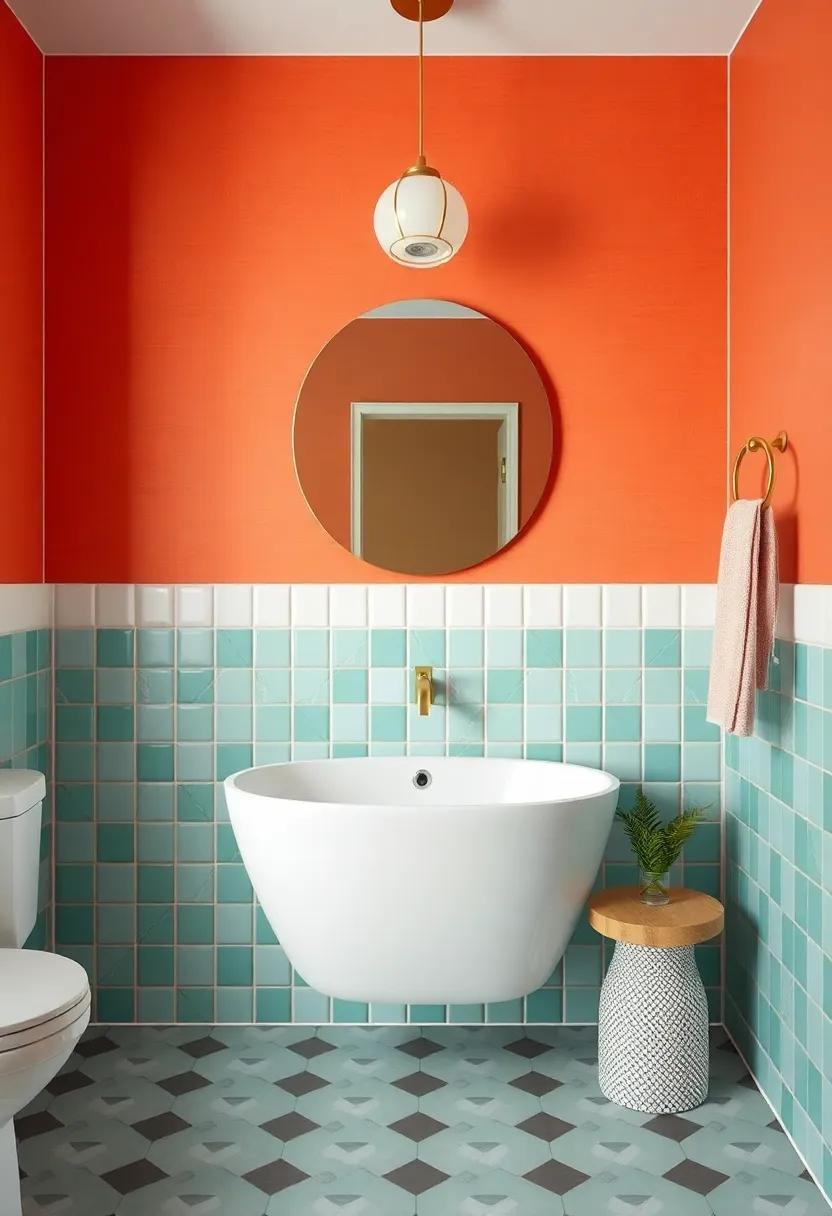
When it comes to infusing retro vibes into your bathroom, bold wallpaper choices are a game-changer. Think geometric patterns, vibrant color palettes, and organic motifs that scream midcentury charm. A feature wall adorned with a striking wallpaper can instantly transport your space back to the 1950s or 60s, creating a focal point that’s both nostalgic and fresh. Pair it with sleek, minimalist fixtures to balance the boldness and let the wallpaper take center stage.
Here are a few wallpaper ideas to inspire your retro revival:
- Palm prints – Perfect for adding a tropical,midcentury flair.
- Atomic starbursts – A nod to the space-age design trends of the era.
- Bold stripes – Ideal for creating a dynamic, energetic vibe.
| Wallpaper Style | Color Palette | Best Paired With |
|---|---|---|
| Geometric Patterns | Mustard, Teal, Coral | Brass Fixtures |
| Organic Motifs | Olive Green, Terracotta | Wooden Accents |
| Abstract Designs | Black, White, Gold | Marble Countertops |
The Charm of Pastel-Colored Tiles in Midcentury Bathrooms
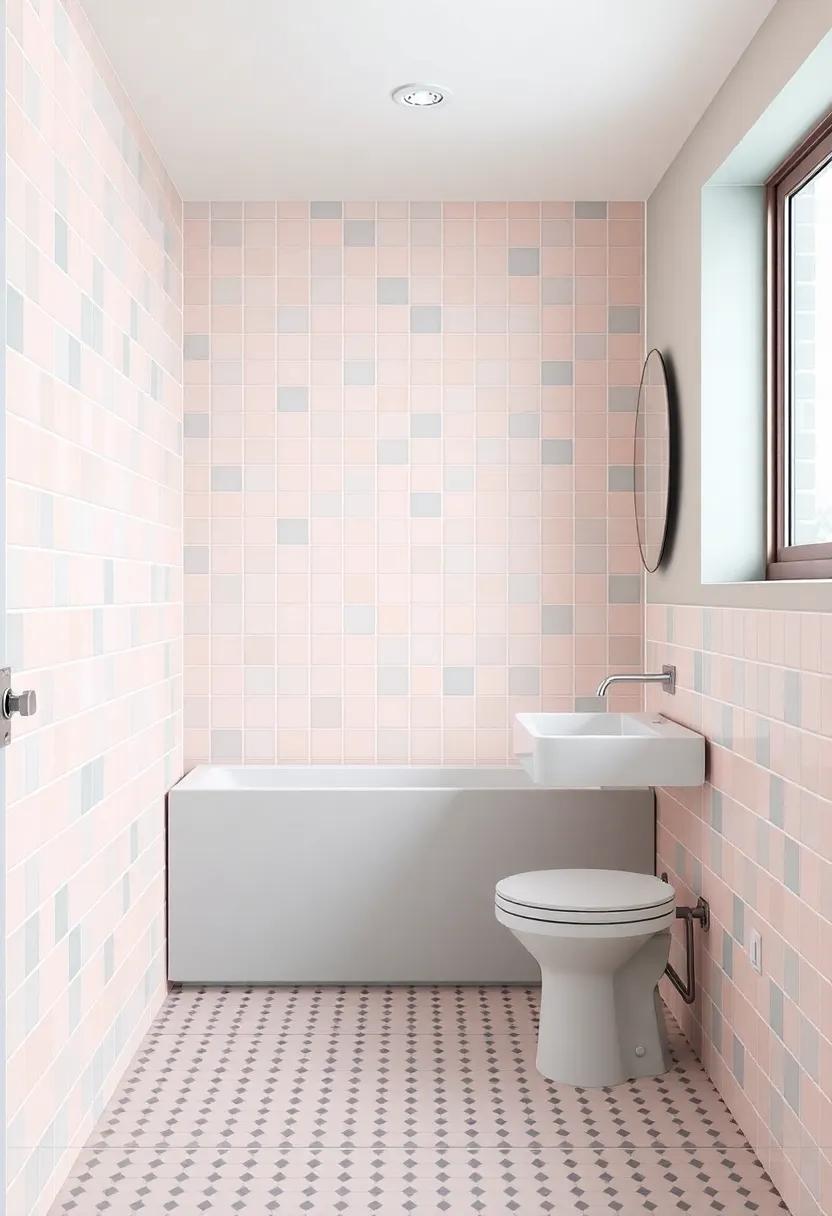
Step into a midcentury bathroom, and you’ll likely be greeted by the soft, soothing hues of pastel-colored tiles. These delicate shades—think mint green, blush pink, and powder blue—were a hallmark of midcentury design, evoking a sense of calm and sophistication. Unlike the bold, saturated colors of earlier decades, pastels brought a fresh, airy feel to bathrooms, making them feel like serene retreats. Whether adorning walls, floors, or shower surrounds, these tiles were often paired with crisp white fixtures and chrome accents, creating a harmonious balance that still feels relevant today.
What makes pastel tiles so enduringly charming is their versatility. They can be used in a variety of patterns and layouts,from simple grid arrangements to intricate geometric designs. Here are a few ways midcentury designers made the most of these tiles:
- Feature Walls: A single wall covered in pastel tiles became a focal point, adding depth without overwhelming the space.
- Checkerboard Floors: Alternating pastel and white tiles created a playful yet elegant look underfoot.
- Accent Borders: Thin bands of pastel tiles framed mirrors or wrapped around the room, adding subtle pops of color.
| Pastel Tile Color | Common Pairings |
|---|---|
| Mint Green | white fixtures, brass accents |
| Blush Pink | Black trim, chrome hardware |
| Powder Blue | Gray grout, natural wood tones |
Today, these pastel tiles are experiencing a revival, as homeowners and designers alike rediscover their timeless appeal. Whether you’re restoring a vintage bathroom or incorporating midcentury elements into a modern space, pastel tiles offer a touch of nostalgia that feels both fresh and familiar.
Midcentury Lighting Fixtures That Illuminate with Style
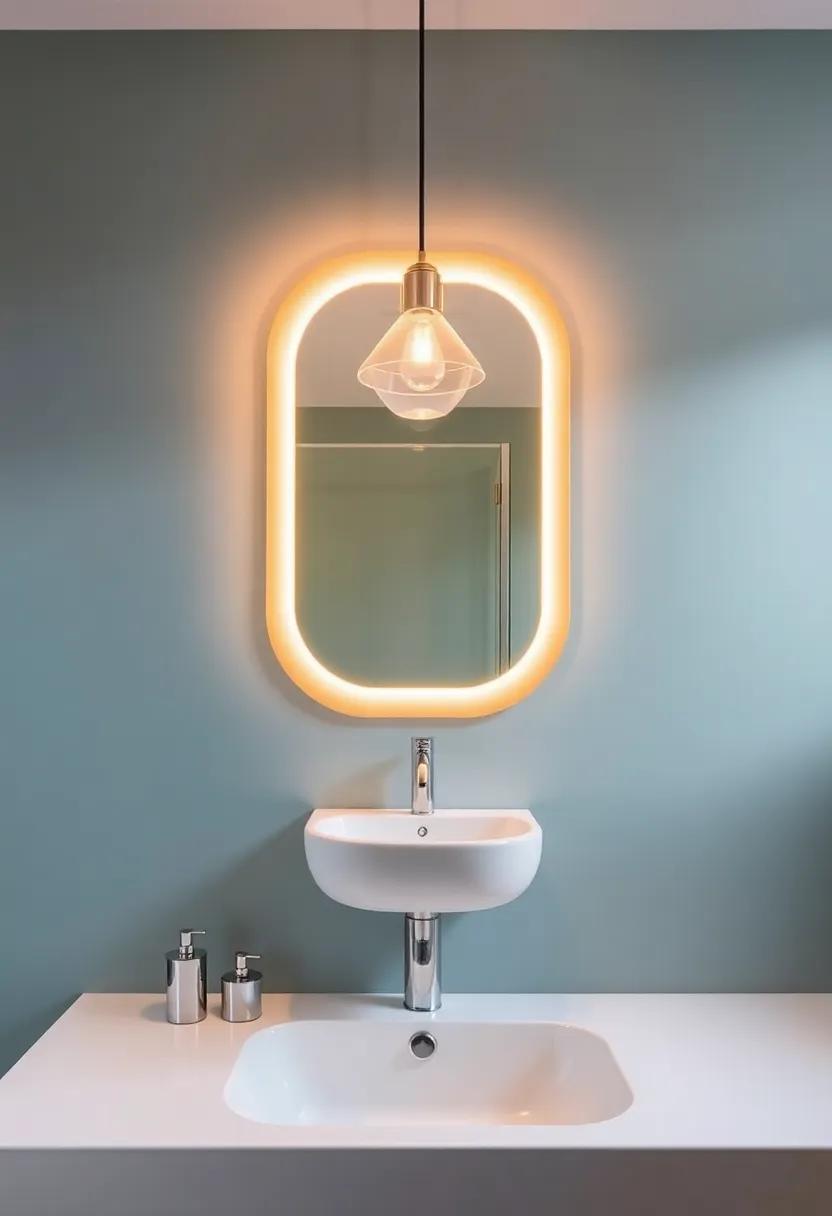
When it comes to midcentury bathroom design, lighting fixtures are more than just functional elements—they’re statement pieces that elevate the entire space. Think sleek, geometric shapes paired with warm metallic finishes like brass, copper, or brushed nickel.These fixtures frequently enough feature clean lines and minimalist designs, perfectly complementing the era’s love for simplicity and functionality. Whether it’s a bold pendant light above the vanity or a pair of sconces framing the mirror, midcentury lighting adds a touch of sophistication and timeless appeal.
Here are some standout midcentury lighting styles to consider for your bathroom:
- Globe Pendants: perfect for creating a soft, diffused glow that enhances the room’s ambiance.
- Sputnik Chandeliers: A bold choice for those who want to make a dramatic statement with their lighting.
- Arched Sconces: Ideal for adding a touch of elegance and symmetry to your vanity area.
- Drum Shades: Simple yet stylish, these fixtures provide a modern twist on classic midcentury design.
| Fixture Type | Best Placement | Material |
|---|---|---|
| Globe Pendant | Above Vanity | Brass |
| Sputnik Chandelier | Center of Bathroom | Polished Chrome |
| Arched Sconce | Beside Mirror | Brushed Nickel |
| Drum Shade | Over Bathtub | Matte Black |
the Role of Chrome and Brass in Retro Bathroom Hardware
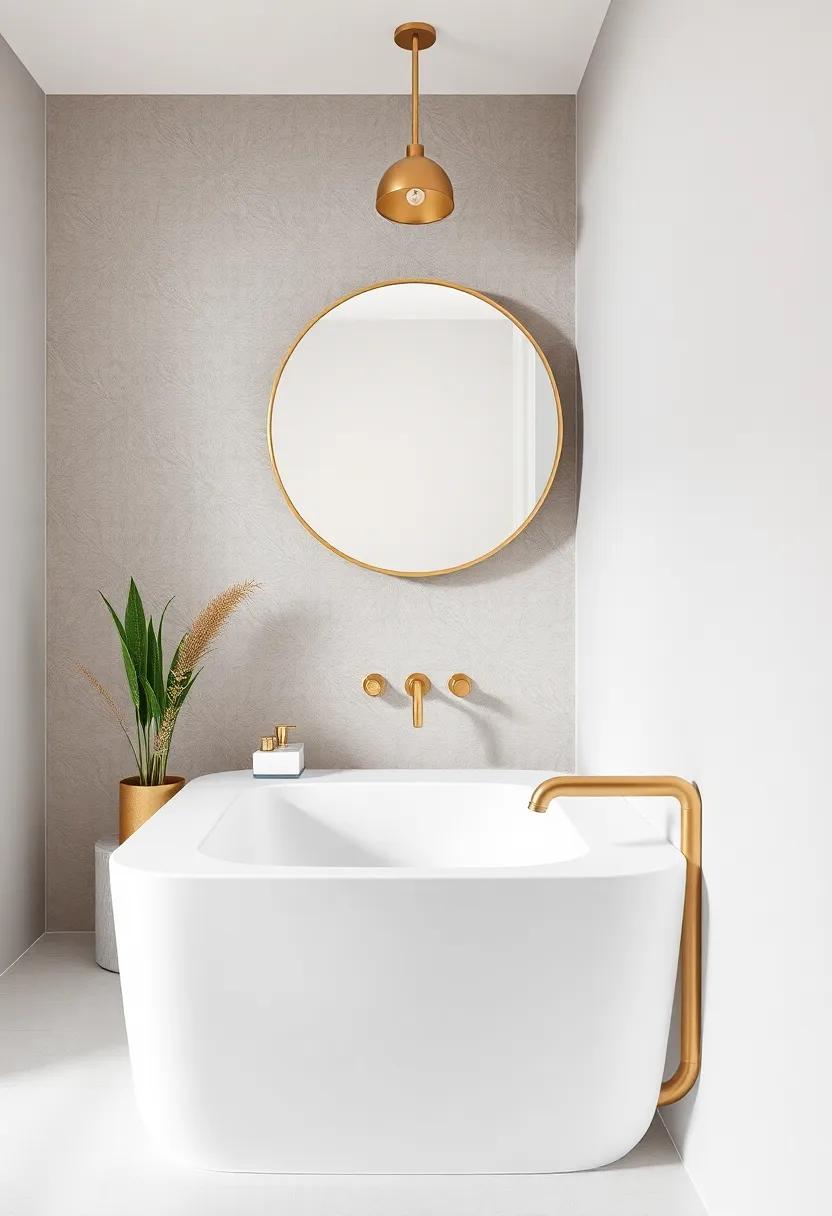
When it comes to midcentury bathroom design, the materials used play a pivotal role in capturing the essence of the era. Chrome and brass are two standout finishes that defined the retro aesthetic, offering both durability and a touch of sophistication. Chrome, with its sleek, reflective surface, became synonymous with modernity, while brass brought warmth and a sense of timeless elegance. Together, they created a harmonious balance that still resonates in today’s retro-inspired spaces.
Here’s why these materials remain a favorite for retro bathroom hardware:
- Chrome: Known for its mirror-like finish, chrome adds a clean, polished look that complements geometric patterns and bold colors often found in midcentury design.
- Brass: With its rich,golden hue,brass introduces a vintage charm that pairs beautifully with earthy tones and organic textures.
- Durability: both materials are resistant to corrosion, making them ideal for humid bathroom environments.
| Material | Key Feature | Design Impact |
|---|---|---|
| Chrome | reflective, modern | Enhances light and space |
| Brass | Warm, vintage | Adds depth and character |
Whether you’re restoring an original midcentury bathroom or incorporating retro elements into a modern space, chrome and brass hardware can elevate the design.Their versatility allows them to blend seamlessly with other materials like ceramic, glass, and wood, ensuring a cohesive and stylish look. By choosing these finishes, you’re not just adding functionality—you’re embracing a piece of design history.
Floating Vanities and Their Connection to Midcentury Minimalism
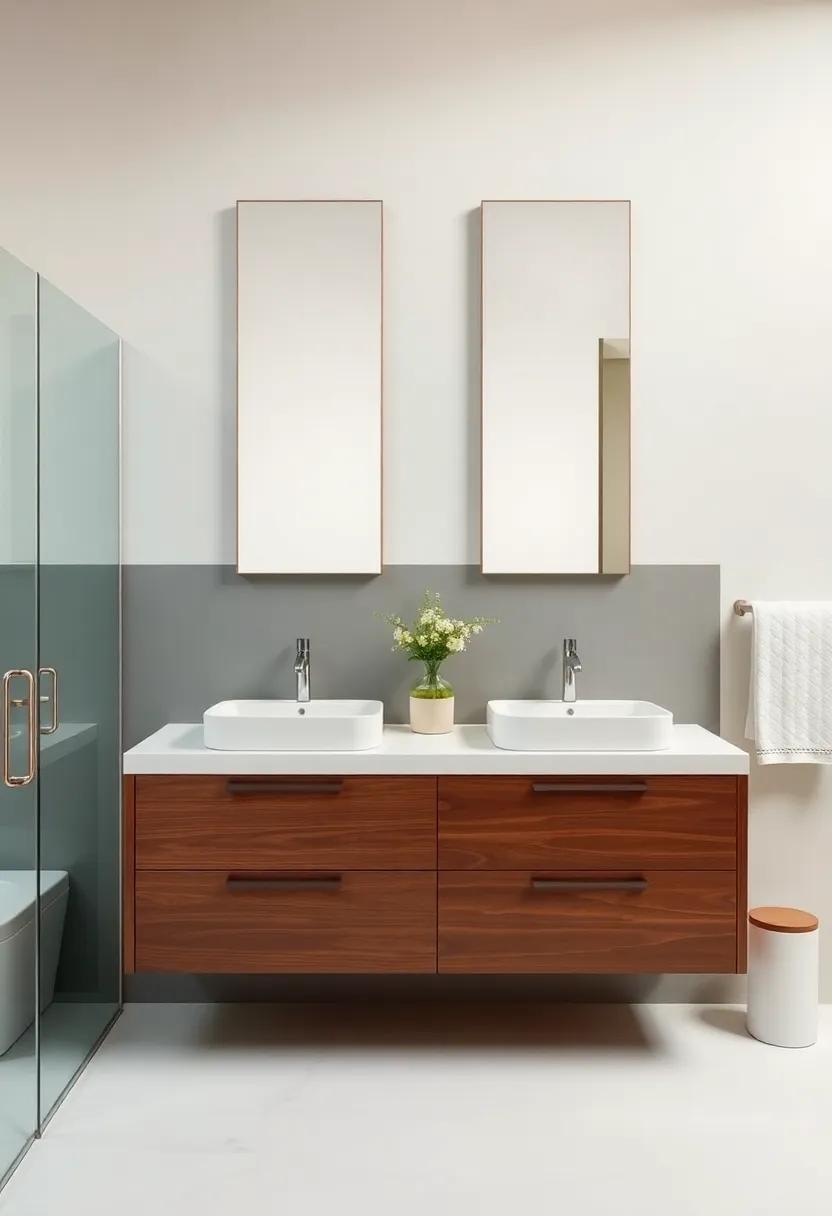
Floating vanities have become a hallmark of modern bathroom design, but their roots trace back to the midcentury era, where minimalism and functionality reigned supreme. These sleek, wall-mounted fixtures embody the essence of midcentury design—clean lines, uncluttered spaces, and a focus on practicality. By elevating the vanity off the floor, they create an illusion of spaciousness, a key principle in midcentury aesthetics. This design choice not only enhances the room’s visual appeal but also makes cleaning a breeze, aligning perfectly with the era’s emphasis on efficiency.
When paired with other midcentury elements,floating vanities can transform a bathroom into a retro-inspired sanctuary. Consider combining them with:
- Warm wood tones for a touch of organic warmth.
- Geometric tile patterns to echo the era’s love for bold shapes.
- Brass or matte black fixtures for a nod to midcentury hardware trends.
| Midcentury Feature | How It Complements Floating Vanities |
|---|---|
| Open Shelving | Enhances the airy feel and provides storage without bulk. |
| Neutral Color Palettes | Creates a cohesive, timeless look that highlights the vanity’s design. |
| Statement lighting | Draws attention to the vanity as a focal point while adding retro flair. |
The Art of Combining Form and Function in Retro Bathroom Design
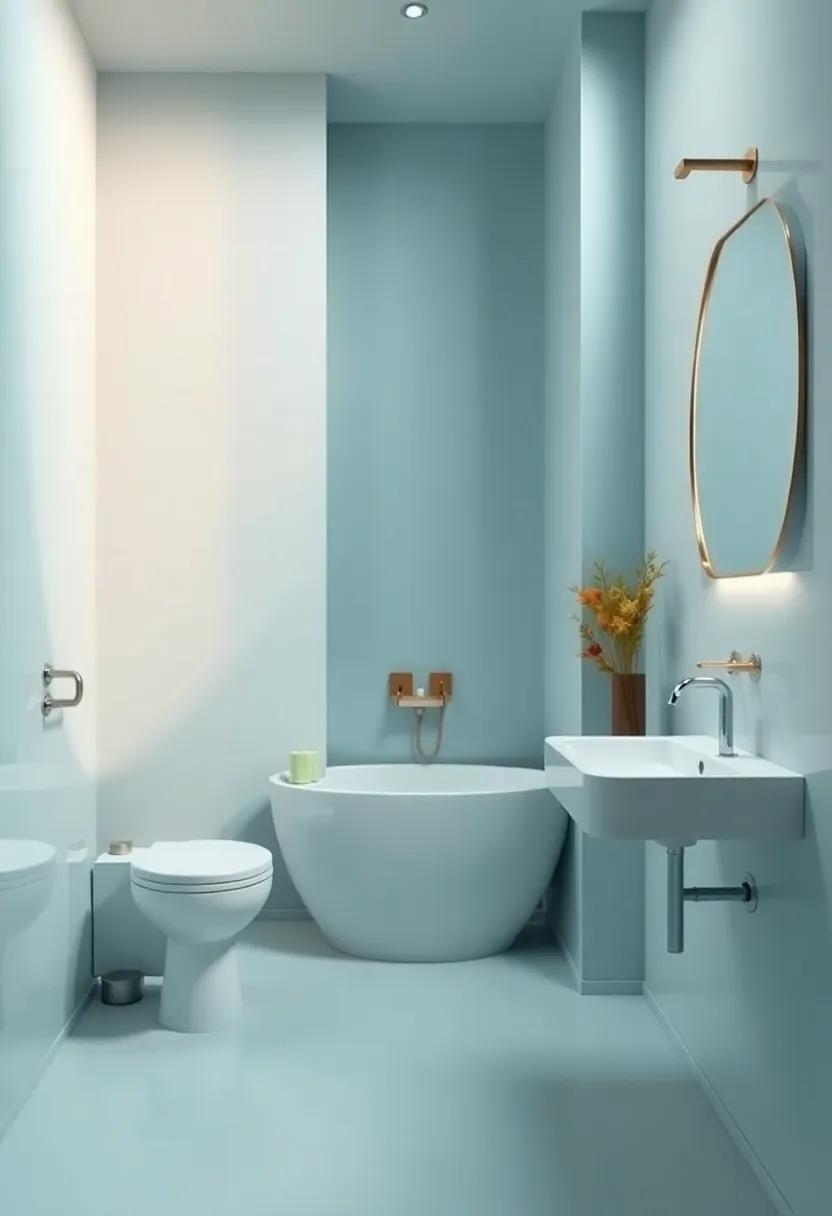
midcentury bathroom design is a masterclass in balancing aesthetics with practicality. The era’s signature clean lines, geometric patterns, and organic shapes create a visually striking yet functional space. Key elements like floating vanities, bold tilework, and streamlined fixtures not only evoke nostalgia but also maximize usability. For instance, a wall-mounted sink frees up floor space, while hexagonal floor tiles add texture without overwhelming the room. The result is a harmonious blend of form and function that feels both timeless and modern.
To achieve this balance, consider incorporating the following design principles:
- Minimalist Fixtures: Opt for sleek, chrome-finished faucets and handles that reflect light and add a touch of sophistication.
- Bold Accents: Use vibrant colors like mustard yellow, teal, or coral in small doses—think towels, shower curtains, or a single accent wall.
- Natural Materials: Introduce warmth with wood or stone elements, such as a teak stool or a marble countertop.
| Element | Function | Aesthetic Impact |
|---|---|---|
| Floating Vanities | Maximizes floor space | Creates a light, airy feel |
| Geometric Tiles | Durable and easy to clean | Adds visual interest and depth |
| Wall-Mounted Lighting | Provides focused illumination | Enhances the retro vibe |
The Timeless Elegance of Clawfoot Tubs in Modern Spaces
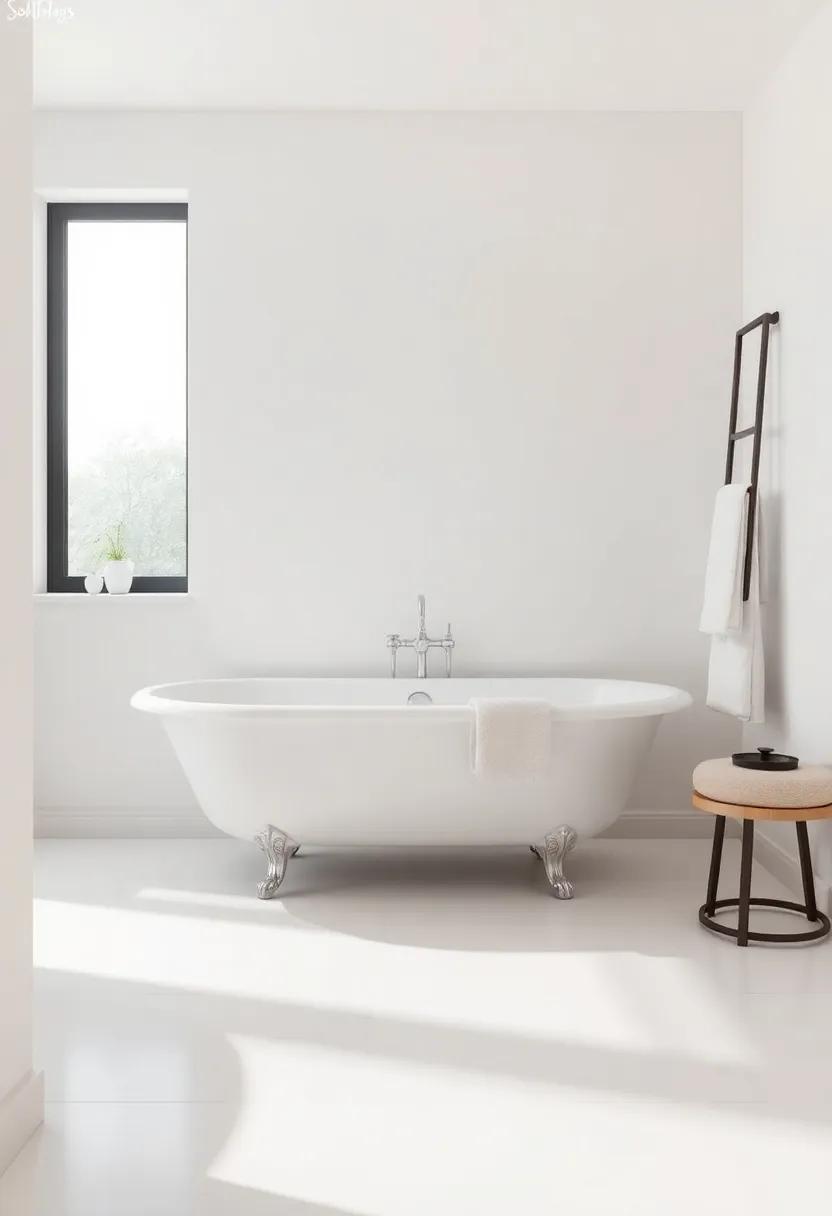
Clawfoot tubs have long been synonymous with luxury and sophistication, and their resurgence in modern spaces is a testament to their enduring appeal. These iconic fixtures effortlessly bridge the gap between vintage charm and contemporary design, offering a focal point that elevates any bathroom. Whether paired with sleek, minimalist finishes or surrounded by ornate, period-inspired details, clawfoot tubs bring a sense of timeless elegance to the room.Their freestanding design allows for versatile placement, making them ideal for both spacious master baths and cozy, tucked-away retreats.
Incorporating a clawfoot tub into your bathroom design opens up a world of creative possibilities. Consider these styling tips to make the most of this classic piece:
- Mix and match: Pair a traditional white clawfoot tub with bold, modern fixtures for a striking contrast.
- Accessorize thoughtfully: Add a vintage-inspired faucet or a rainfall showerhead to enhance the tub’s functionality and aesthetic.
- Play with textures: surround the tub with natural materials like wood or stone to create a warm, inviting atmosphere.
| Feature | Benefit |
|---|---|
| Freestanding Design | Allows for flexible placement and easy cleaning. |
| Timeless Aesthetic | Complements both vintage and modern decor styles. |
| Durable Materials | Often made from cast iron or acrylic for long-lasting use. |
The Influence of Scandinavian Design on Midcentury Bathrooms
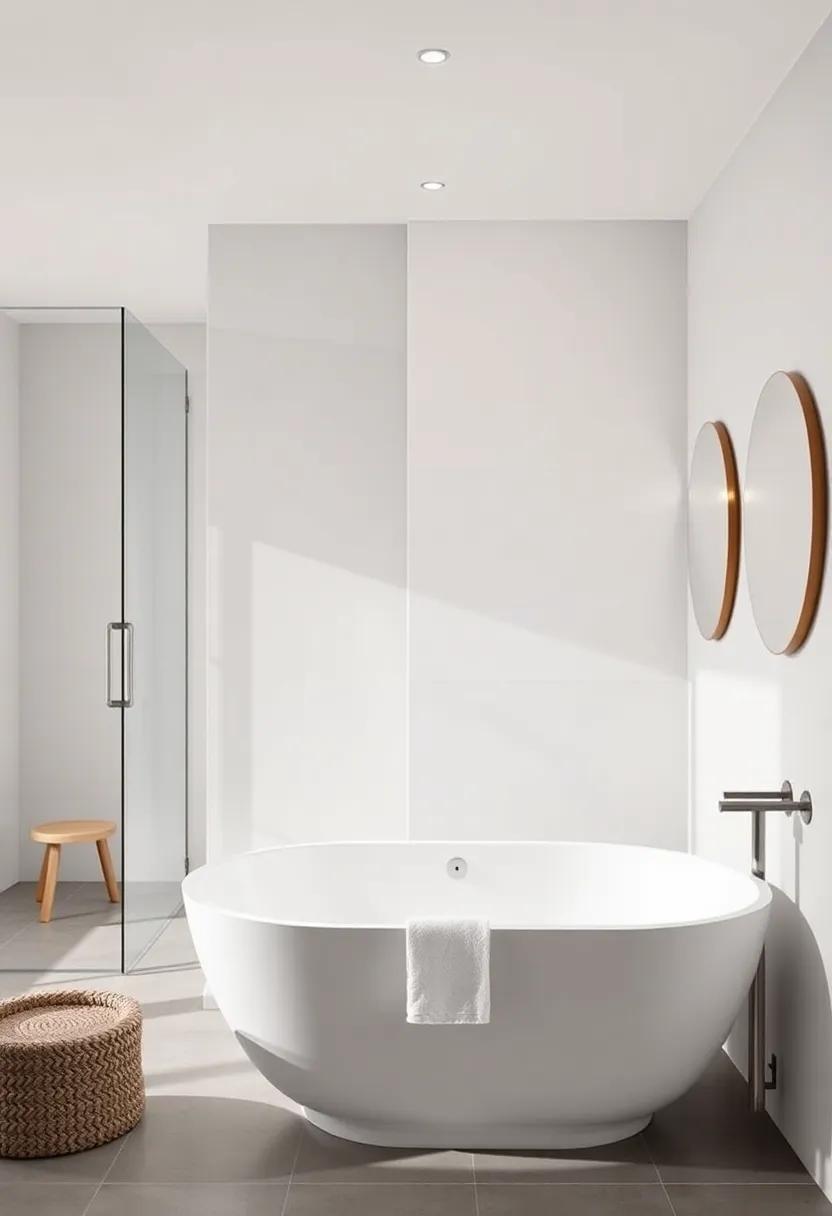
Scandinavian design has left an indelible mark on midcentury bathrooms, blending functionality with minimalist aesthetics. Known for its clean lines, natural materials, and muted color palettes, this design beliefs transformed bathrooms into serene, spa-like retreats. The use of light wood tones, such as teak or birch, became a hallmark, paired with white tiles and matte fixtures to create a harmonious balance. Scandinavian influence also introduced the concept of open shelving and built-in storage, ensuring that every element served a purpose without compromising on style.
One of the most enduring legacies of Scandinavian design in midcentury bathrooms is the emphasis on natural light and uncluttered spaces. Large windows, often framed with simple, understated curtains, allowed sunlight to flood the room, enhancing the sense of openness. The integration of organic shapes, such as oval mirrors or curved vanities, softened the geometric rigidity typical of midcentury design. Below is a table showcasing key elements that highlight the Scandinavian influence:
| Element | Scandinavian Influence |
|---|---|
| Color Palette | Soft whites, grays, and earthy tones |
| Materials | Light woods, ceramic, and stone |
| Fixtures | Matte finishes, simple shapes |
| Storage | Built-in solutions, open shelving |
The Playful Use of Color Blocking in retro Bathroom Themes
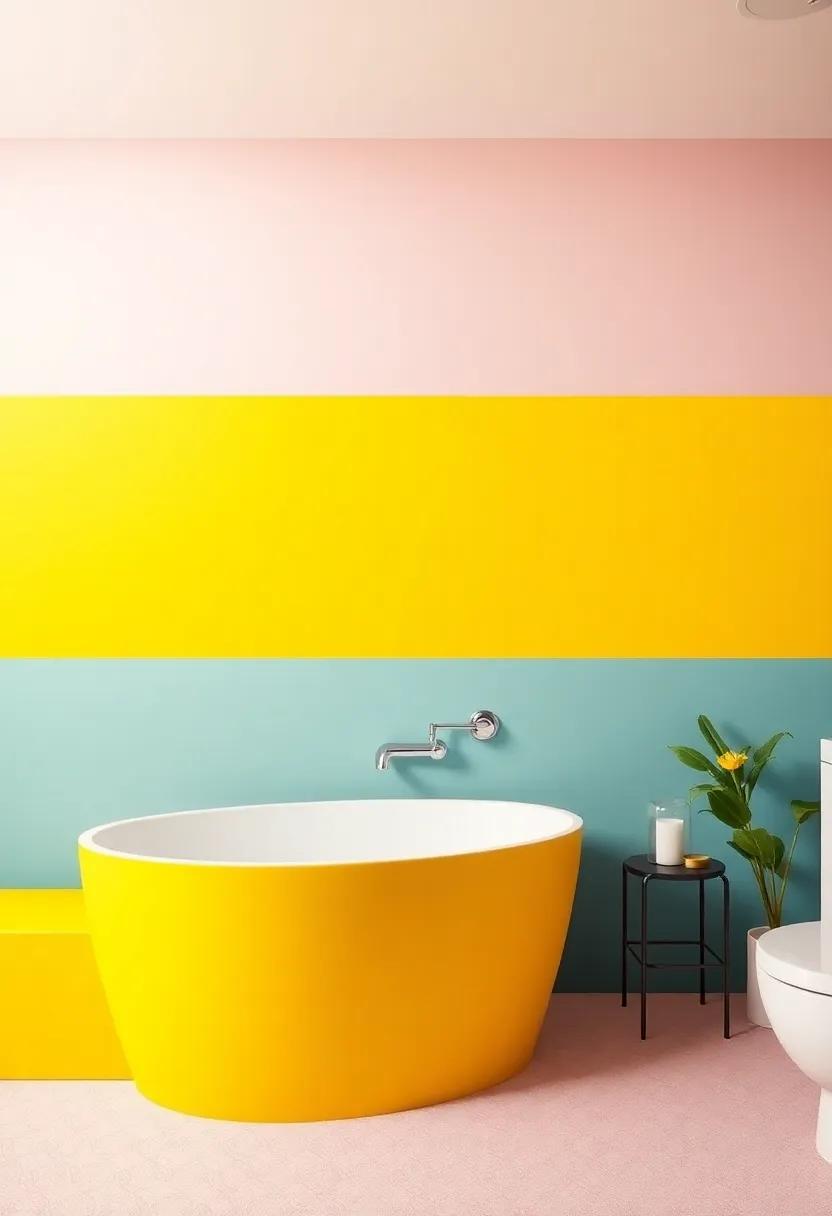
One of the most striking elements of midcentury bathroom design is the bold and playful use of color blocking. This technique, which involves pairing contrasting hues in large, geometric sections, brings a sense of energy and vibrancy to the space. Think sunny yellows paired with deep teals, or coral pinks juxtaposed against mint greens. These combinations not only evoke the optimism of the era but also create a visually dynamic habitat that feels both retro and refreshingly modern.
To achieve this look, consider incorporating color blocking in key areas of your bathroom. Such as:
- Walls: Paint one wall in a bold hue and the adjacent wall in a complementary shade.
- Tiles: Use checkerboard or geometric tile patterns to create a playful floor or backsplash.
- Fixtures: Opt for colorful sinks, bathtubs, or cabinets to anchor the design.
| Color Combination | Mood |
|---|---|
| Mustard yellow + Olive Green | Earthy and Warm |
| Baby Blue + Cherry Red | Playful and Bold |
| Peach + Turquoise | Soft and Inviting |
The Subtle Sophistication of Subway Tiles in Midcentury Design
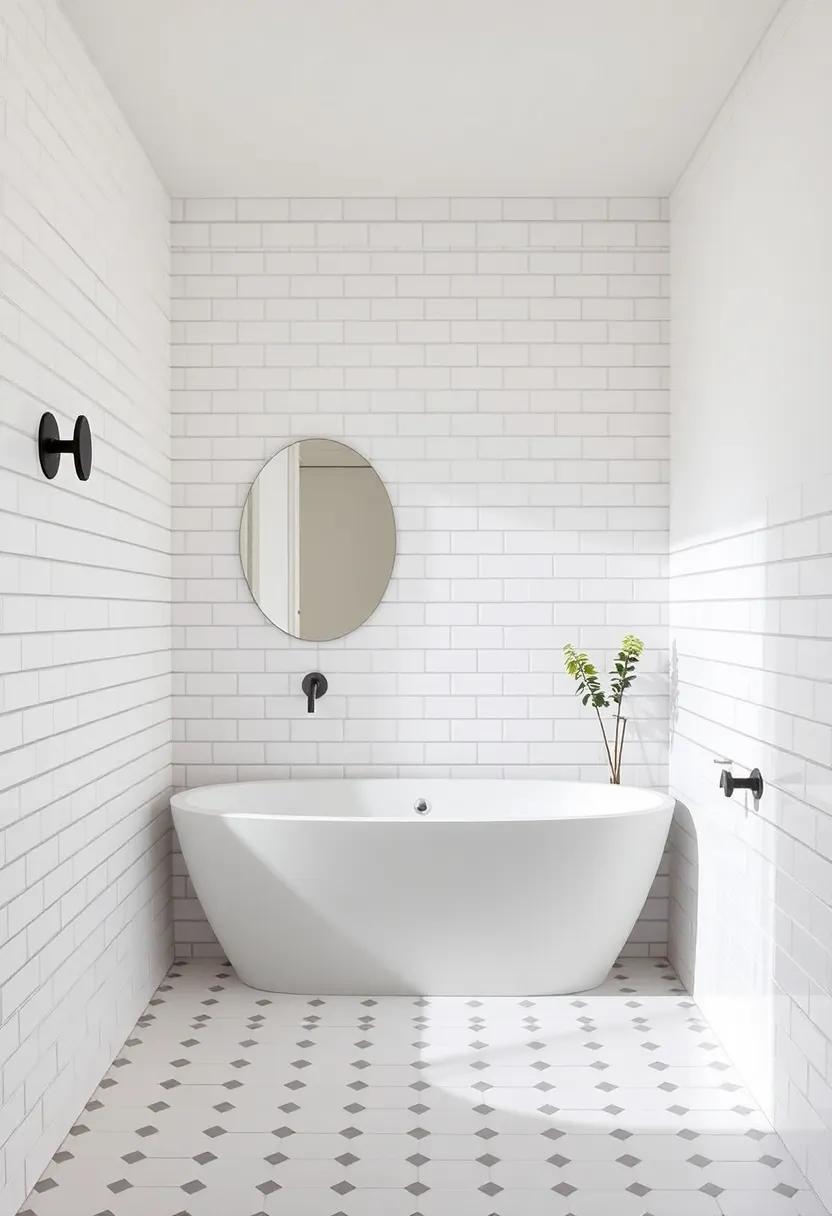
Subway tiles,with their clean lines and understated elegance,have long been a staple in midcentury design. Their versatility allows them to seamlessly blend into both minimalist and bold design schemes, making them a perfect choice for bathrooms. The horizontal or vertical stacking of these tiles creates a sense of movement, while their glossy finish reflects light, enhancing the space’s brightness and openness. Paired with muted pastels or earthy tones, subway tiles evoke a sense of nostalgia, transporting you back to the golden era of midcentury modernism.
What makes subway tiles truly timeless is their ability to adapt to various design elements. Consider pairing them with:
- Vintage fixtures: Chrome faucets and brass accents add a touch of authenticity.
- Geometric patterns: Hexagonal floor tiles or bold wallpaper create a striking contrast.
- Natural materials: Teak vanities or marble countertops bring warmth and texture.
| Tile Color | Recommended Pairing | Mood |
|---|---|---|
| Classic White | Black accents | Clean & Crisp |
| Soft Mint | Warm wood tones | Calm & Serene |
| Charcoal Gray | Gold fixtures | Modern & Luxe |
The Revival of Glass Block walls in Retro Bathroom Aesthetics
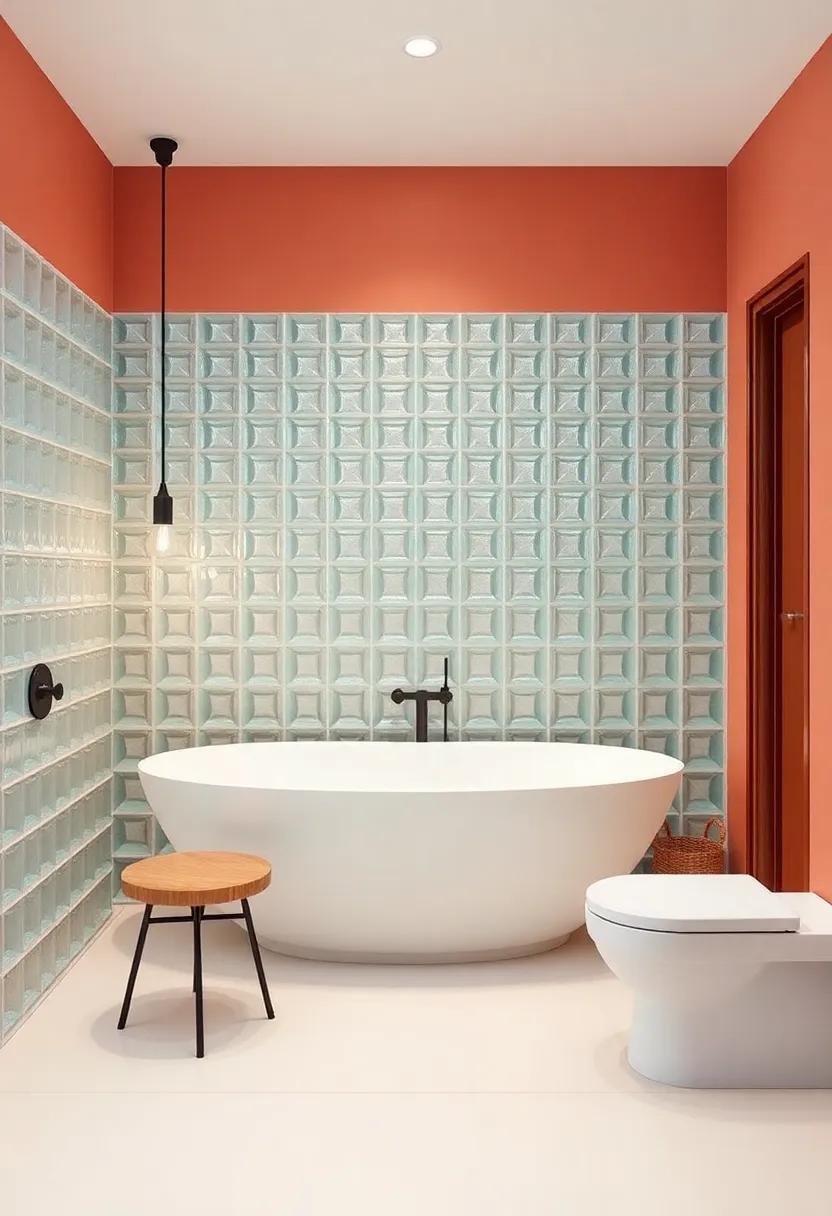
Once considered a relic of the past, glass block walls are making a bold comeback in retro-inspired bathrooms. These translucent marvels, popularized in the mid-20th century, are now being reimagined to blend vintage charm with modern functionality. Their ability to diffuse light while maintaining privacy makes them a perfect choice for bathrooms, creating a soft, ethereal glow that enhances the space. Designers are pairing glass blocks with sleek fixtures and bold color palettes, proving that this retro element can feel fresh and contemporary.
here are a few ways glass block walls are being used in today’s retro bathroom designs:
- Accent Walls: A single glass block wall can serve as a striking focal point, especially when paired with geometric tiles or matte black hardware.
- Shower Enclosures: Replacing traditional shower doors with glass blocks adds texture and visual interest while maintaining an open, airy feel.
- Partition Walls: Perfect for separating spaces in larger bathrooms, glass block partitions offer privacy without sacrificing natural light.
| feature | Benefit |
|---|---|
| Light Diffusion | Creates a soft, ambient glow |
| privacy | Obscures views while allowing light |
| Durability | Resistant to moisture and easy to clean |
The harmony of Organic Shapes and Clean Lines in Midcentury Bathrooms
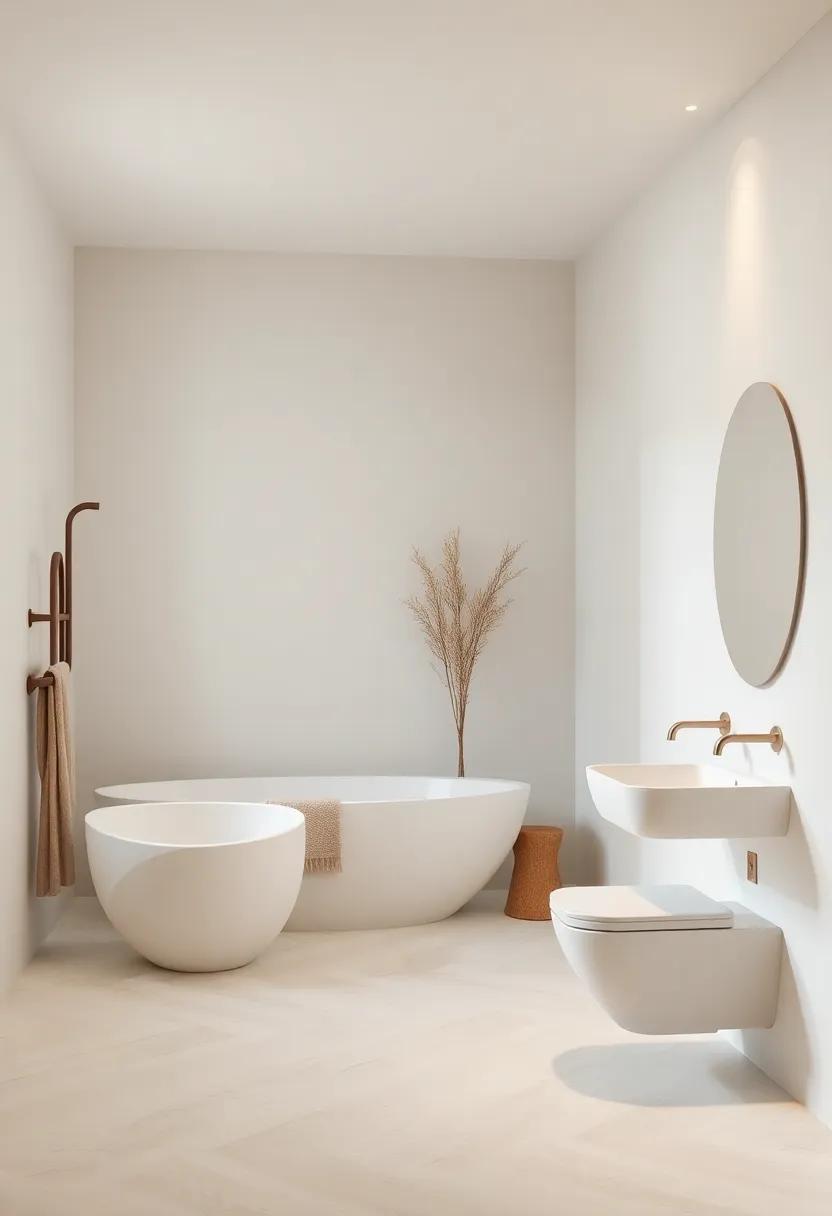
Midcentury bathrooms are a masterclass in balancing organic forms with structured simplicity. The era’s designers embraced the beauty of nature, incorporating curved vanities, pebble-shaped tiles, and rounded mirrors to soften the space. Yet, they paired these elements with clean, geometric lines—think rectangular tubs, angular faucets, and linear shelving.This juxtaposition creates a harmonious blend that feels both inviting and refined,a hallmark of midcentury design.
To achieve this balance in your own bathroom, consider the following:
- Organic Accents: Introduce natural materials like teak, stone, or cork to add warmth and texture.
- Clean Lines: Opt for minimalist fixtures and hardware with sharp, unadorned edges to maintain a sleek aesthetic.
- Color Palette: Stick to earthy tones like olive green,mustard yellow,or soft gray,complemented by crisp white or black accents.
| Element | Organic | Clean Lines |
|---|---|---|
| Vanity | curved edges | Flat-front drawers |
| Lighting | Globe pendants | Linear sconces |
| Tile | Hexagonal or pebble shapes | Subway or square tiles |
The Role of Mirrors in Enhancing Retro Bathroom Spaces
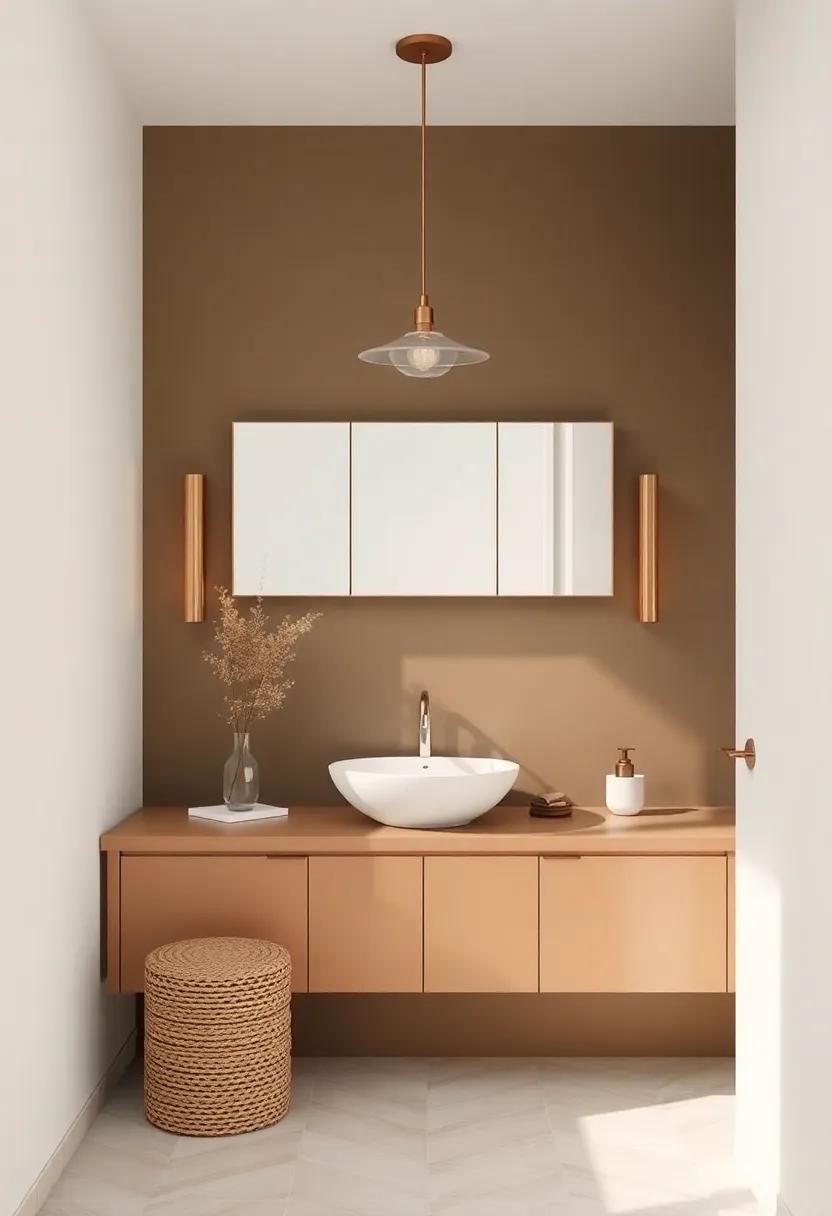
Mirrors are more than just functional elements in a retro bathroom; they are design statements that amplify the charm of midcentury aesthetics. A well-chosen mirror can act as a focal point, reflecting light and creating the illusion of space, which is especially valuable in smaller bathrooms. Consider arched or sunburst mirrors to evoke a sense of nostalgia,or opt for oval frames with metallic finishes to complement vintage fixtures. Pairing mirrors with bold, geometric patterns or pastel-colored walls can further enhance the retro vibe, making the space feel cohesive and thoughtfully curated.
When selecting mirrors for a midcentury-inspired bathroom, think beyond their reflective surface. The frame material and shape play a pivotal role in tying the design together. Here are a few ideas to elevate your retro bathroom:
- Teak or Walnut Frames: These natural wood finishes add warmth and authenticity to the space.
- Circular or Asymmetrical Shapes: Unconventional designs can break the monotony and add visual interest.
- Integrated Lighting: Vintage-style sconces or backlit mirrors can enhance functionality while maintaining the retro aesthetic.
| Mirror Style | Best paired With |
|---|---|
| Sunburst | Pastel tiles, brass fixtures |
| Oval with Metallic Frame | Black-and-white checkered floors |
| Circular Wooden Frame | Terrazzo countertops, matte finishes |
The Integration of Indoor plants in Midcentury Bathroom Decor
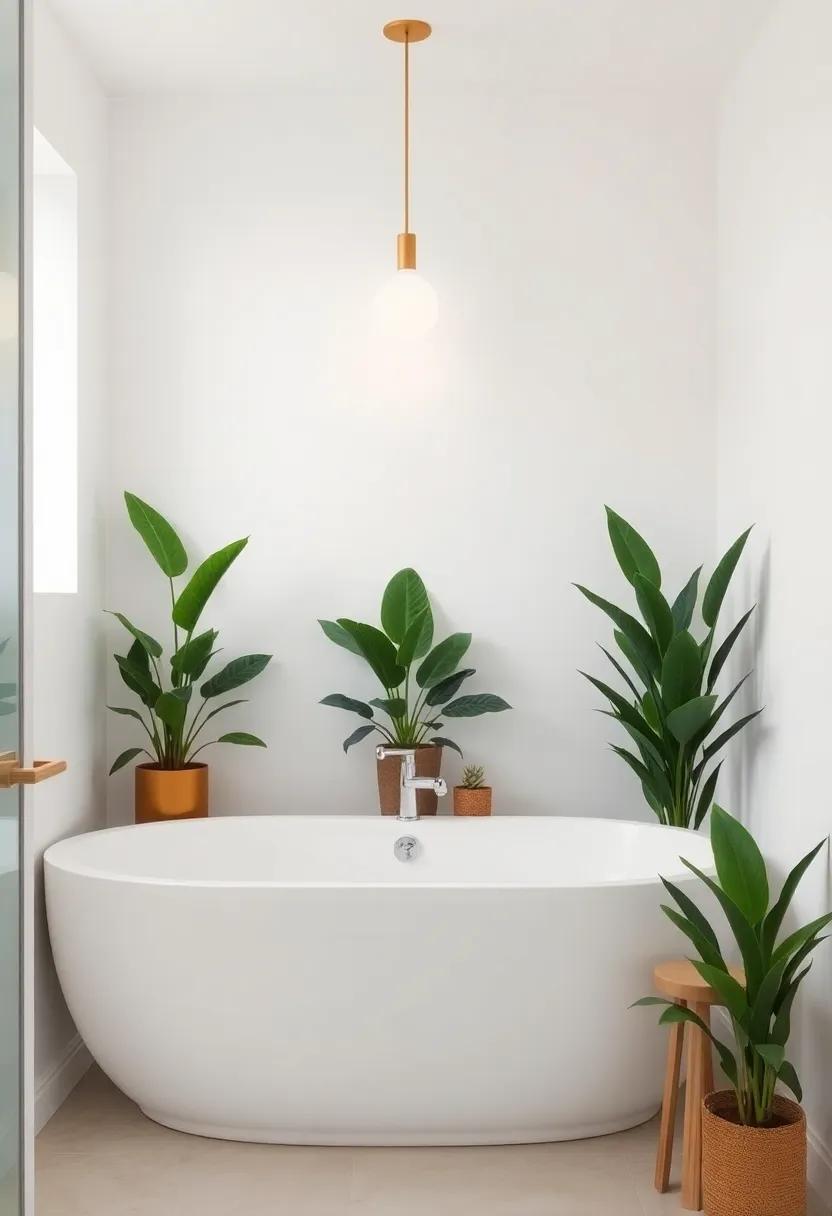
Midcentury bathroom design is renowned for its clean lines, organic shapes, and seamless connection to nature. One of the most striking ways to enhance this aesthetic is through the integration of indoor plants. Plants not only add a touch of greenery but also complement the era’s emphasis on bringing the outdoors inside. Consider incorporating low-maintenance species like snake plants, pothos, or ferns, which thrive in humid environments and require minimal care. These plants can be placed in ceramic or terracotta pots that echo the earthy tones and textures of midcentury decor, creating a harmonious blend of form and function.
To maximize the impact of greenery in your midcentury bathroom, think about placement and scale. A hanging planter near a window can add vertical interest, while a small potted plant on a floating shelf can soften the sharp lines of a vanity. for a bold statement, try grouping plants of varying heights and textures in a corner or near a bathtub. Below is a simple guide to pairing plants with midcentury bathroom elements:
| Plant | Midcentury Element | Effect |
|---|---|---|
| Snake Plant | Wooden Vanity | Adds contrast with vertical lines |
| Pothos | Floating Shelves | Softens edges with cascading vines |
| Fern | Freestanding Tub | Creates a spa-like, organic feel |
- Tip: use macramé hangers for a retro touch that complements the midcentury vibe.
- Tip: Opt for plants with glossy leaves to reflect light and enhance the space’s brightness.
The Nostalgic Appeal of Vintage Towel Bars and Accessories
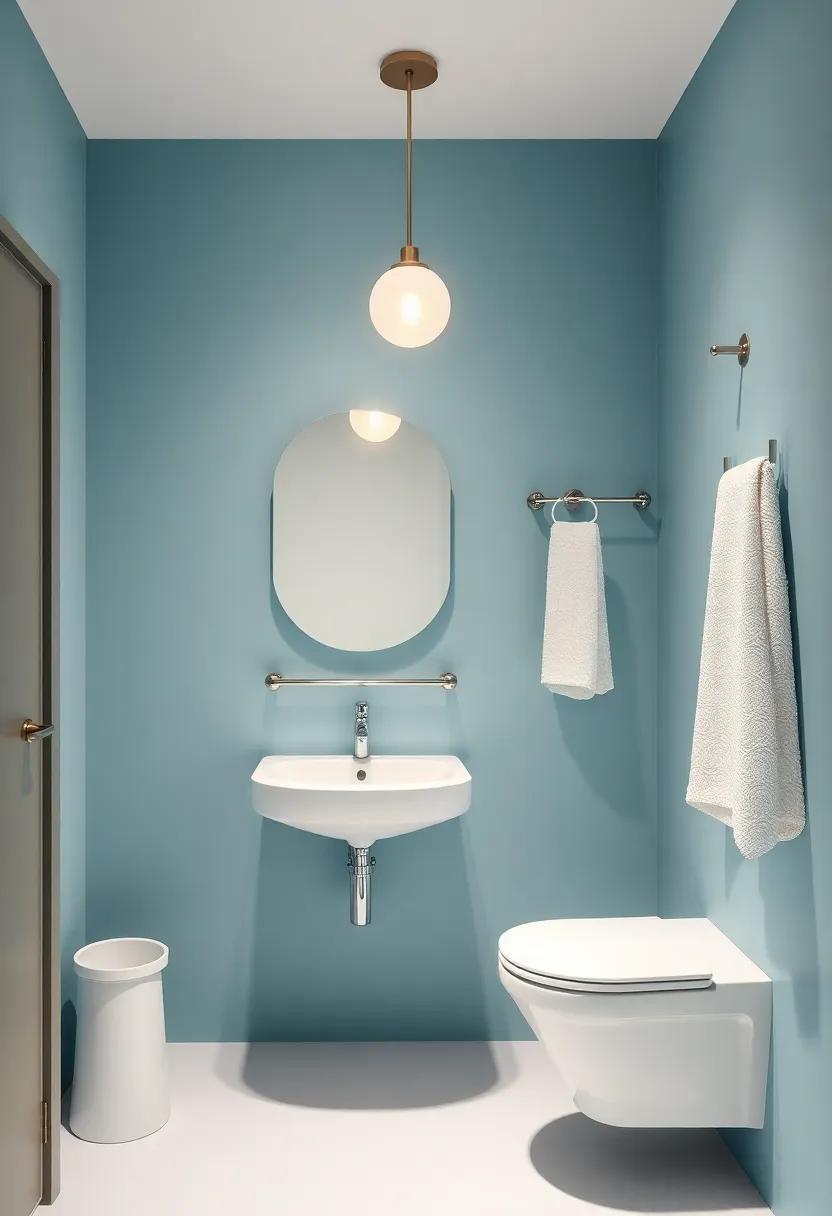
There’s somthing undeniably captivating about the midcentury aesthetic, especially when it comes to bathroom design. Vintage towel bars and accessories, with their sleek lines and understated elegance, evoke a sense of nostalgia that modern fixtures often lack. These pieces, crafted from materials like brushed brass, chrome, or even ceramic, bring a touch of timeless sophistication to any space. Whether it’s a minimalist towel rack or a retro soap dish, each accessory tells a story of an era where form and function were perfectly balanced.
Incorporating these elements into your bathroom doesn’t just add visual appeal—it creates a cohesive, curated look. Consider pairing a vintage-inspired towel bar with matching hooks or a midcentury vanity to complete the theme. Below is a quick guide to some popular vintage-inspired materials and their modern applications:
| Material | Modern Application |
|---|---|
| Brushed Brass | Warm, durable, and perfect for towel bars or faucets. |
| Chrome | Timeless and versatile, ideal for hooks or soap dispensers. |
| Ceramic | Adds a pop of color and texture, great for soap dishes. |
- Mix and match: Combine different materials for a layered, eclectic look.
- Focus on details: Opt for accessories with subtle geometric patterns or textured finishes.
- Keep it functional: Choose pieces that are as practical as they are stylish.
The Balance of Open Shelving and closed Storage in Retro Bathrooms
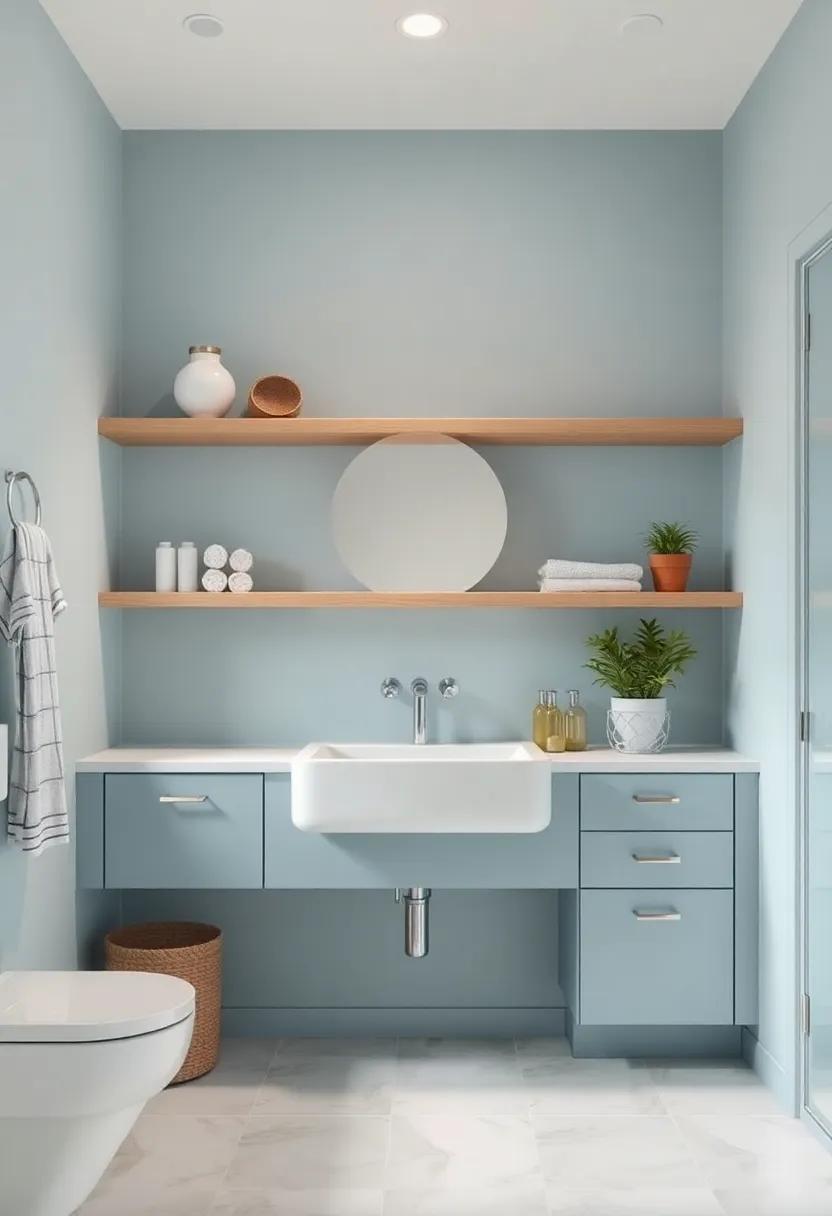
In retro bathrooms, the interplay between open shelving and closed storage is key to achieving both functionality and aesthetic appeal. Open shelving,often crafted from warm woods or sleek metals,provides a perfect stage for displaying vintage-inspired decor,such as apothecary jars,ceramic soap dishes,or lush greenery.This approach not only enhances the visual charm but also keeps essentials within easy reach. Conversely,closed storage solutions,like mirrored cabinets or streamlined vanities,offer a clean,clutter-free look while preserving the midcentury vibe.the trick lies in balancing the two—too much open shelving can feel chaotic, while excessive closed storage may appear sterile.
To strike the right equilibrium, consider the following:
- mix Materials: Combine wood, metal, and glass to add texture and depth.
- Prioritize Function: Use closed storage for items you want hidden, like toiletries or cleaning supplies.
- Curate Displays: Limit open shelving to a few carefully chosen items to avoid visual overload.
| Storage Type | Best Use | Material Suggestions |
|---|---|---|
| Open Shelving | Display decor, towels, or frequently used items | Teak, brass, or glass |
| Closed Storage | Conceal toiletries, cleaning supplies, or personal items | Laminated wood, chrome, or mirrored surfaces |
The Impact of Textured Surfaces in Midcentury Bathroom Design
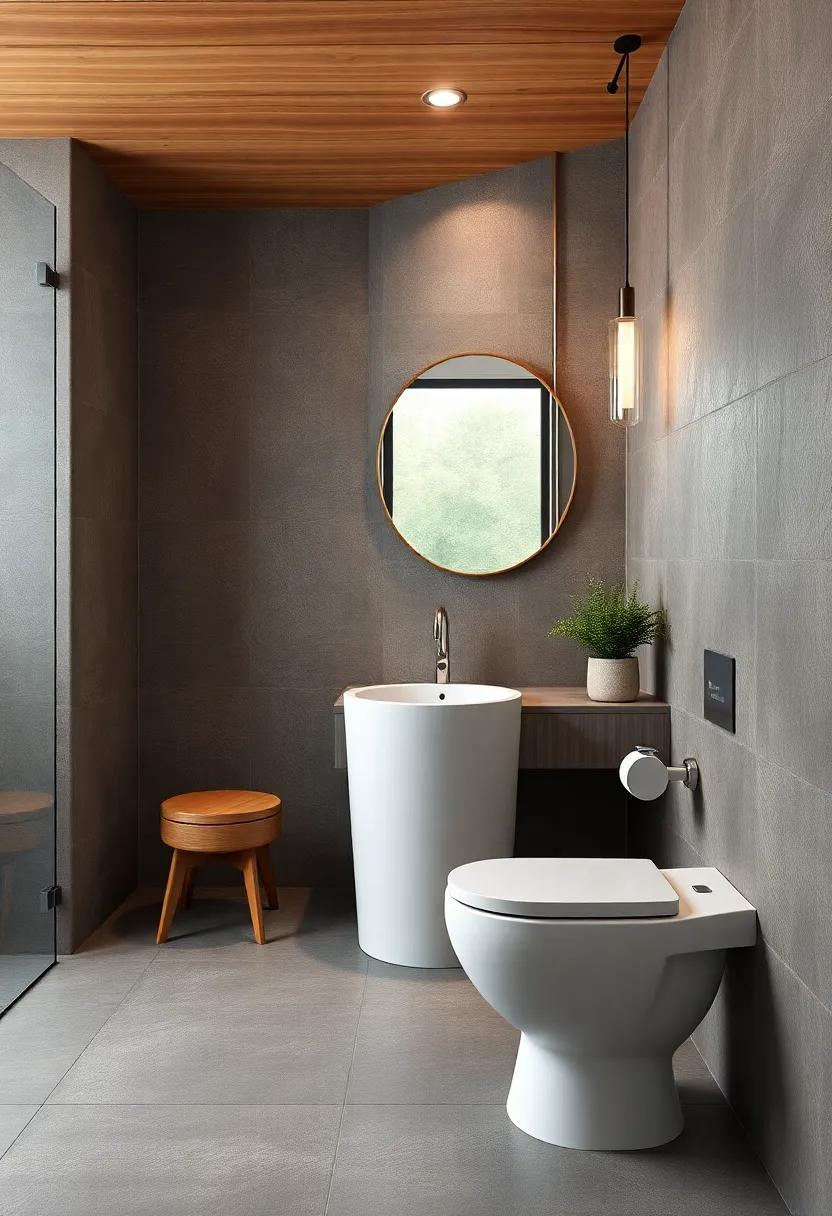
Midcentury bathroom design is celebrated for its ability to blend functionality with aesthetic appeal, and textured surfaces play a pivotal role in achieving this balance. From pebbled tiles to ribbed glass partitions, these tactile elements add depth and character to spaces that might or else feel sterile. Textured surfaces were not just decorative; they served practical purposes, such as enhancing grip in wet areas or diffusing light to create a softer ambiance. This thoughtful integration of form and function is what makes midcentury design so enduring.
In modern retro-inspired bathrooms, textured surfaces are making a strong comeback. Designers are reimagining classic materials like terrazzo and mosaic tiles to suit contemporary tastes while maintaining their vintage charm. Below is a quick guide to popular textured surfaces and their applications:
| Material | Application |
|---|---|
| Pebbled Tiles | Shower floors, accent walls |
| Ribbed Glass | Partitions, cabinet doors |
| Terrazzo | Countertops, flooring |
| Mosaic Tiles | Backsplashes, feature walls |
These materials not only evoke nostalgia but also offer versatility, allowing homeowners to mix and match textures for a truly personalized space. Whether you’re aiming for a subtle nod to the past or a full-blown retro revival, textured surfaces are a key ingredient in capturing the timeless charm of midcentury design.
The Timeless Appeal of black and White Checkered Floors
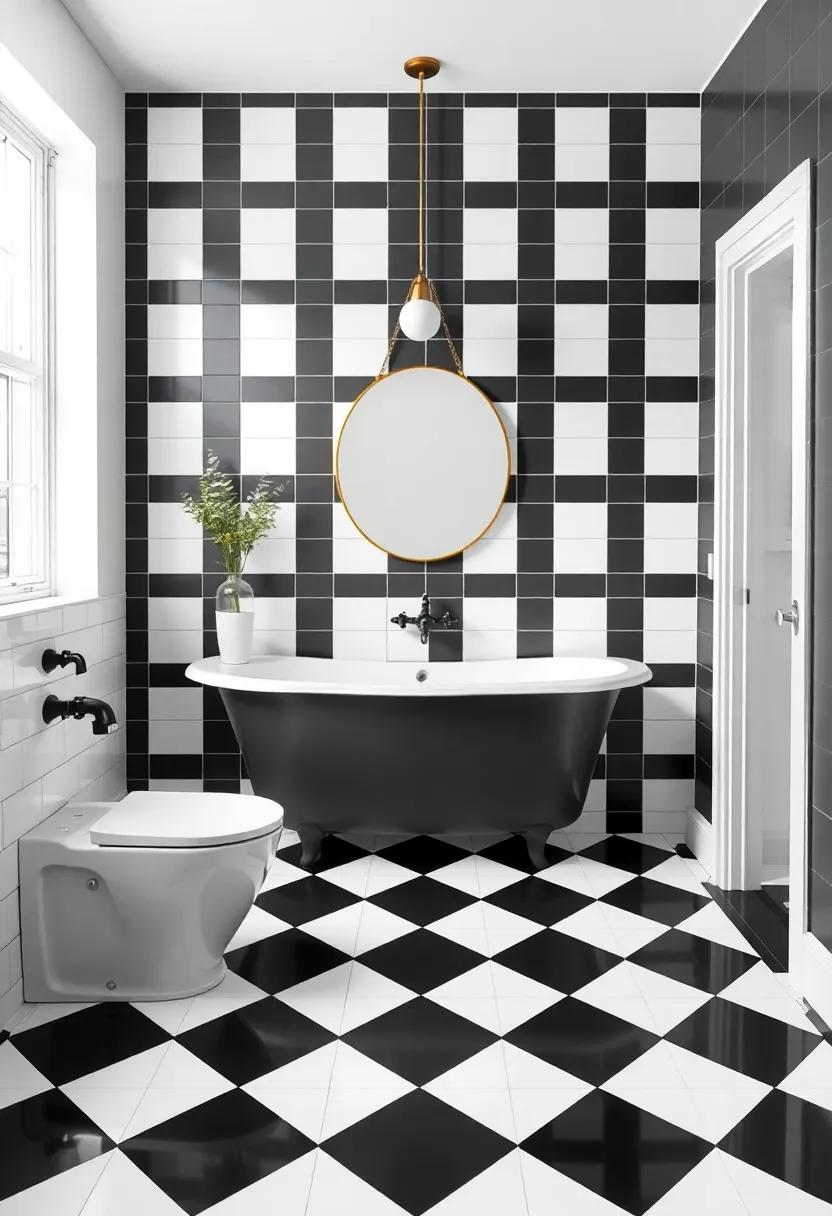
Black and white checkered floors have long been a hallmark of midcentury design,effortlessly blending retro charm with modern versatility. Their bold, graphic pattern creates a striking visual impact, making them a perfect choice for bathrooms that aim to balance nostalgia with contemporary flair. The contrast between the two colors not only adds depth to the space but also serves as a timeless backdrop for both minimalist and eclectic decor styles. Whether paired with sleek chrome fixtures or vintage-inspired accents, this classic flooring choice never fails to evoke a sense of sophistication and playfulness.
What makes black and white checkered floors truly enduring is their ability to adapt to various design aesthetics. Here are a few ways to incorporate them into your bathroom:
- pair with pastel tones: Soft pinks, mint greens, or pale blues can soften the boldness of the pattern, creating a harmonious balance.
- Add metallic accents: Gold, brass, or silver fixtures can elevate the look, adding a touch of glamour.
- Mix textures: Combine the flooring with natural materials like wood or stone to add warmth and dimension.
| Design Element | Pairing Suggestion |
|---|---|
| Wall Color | Neutral tones like beige or gray |
| Lighting | Vintage-inspired sconces or pendant lights |
| Accessories | Black-and-white artwork or geometric patterns |
Wrapping Up
As we close the door on this journey through the timeless allure of midcentury bathroom design, it’s clear that this retro revival is more than just a fleeting trend—it’s a celebration of enduring style.The clean lines, bold colors, and thoughtful functionality of the midcentury era continue to inspire, proving that good design transcends time. Whether you’re restoring a vintage gem or infusing modern spaces with a touch of retro flair, the charm of midcentury design invites us to slow down, appreciate the details, and create spaces that feel both nostalgic and refreshingly alive. So, as you step into your own bathroom sanctuary, remember: the past isn’t just behind us—it’s a wellspring of inspiration, waiting to be rediscovered.
 decorifusta Garden and patio decoration inspiration
decorifusta Garden and patio decoration inspiration 